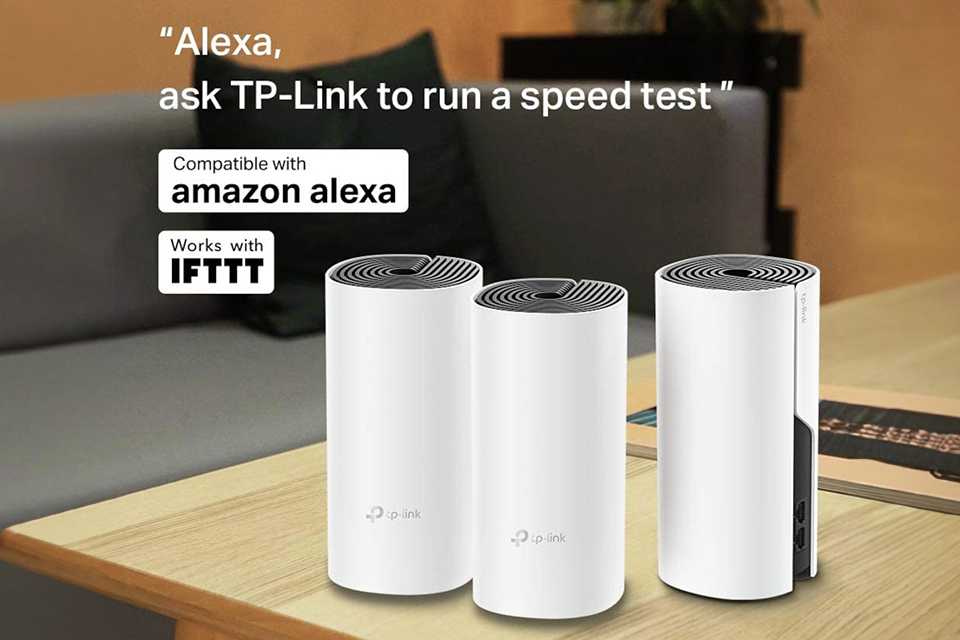Beginner's guide to mesh wifi
From modems to mesh, find the best networking set up for your home.
Shop all mesh wifiFrom modems to mesh, find the best networking set up for your home.
Shop all mesh wifi&poi={$this.metadata.pointOfInterest.x},{$this.metadata.pointOfInterest.y},{$this.metadata.pointOfInterest.w},{$this.metadata.pointOfInterest.h}&scaleFit={($this.metadata.pointOfInterest.x>0)?$sfpoi:$sfcenter}&sm=aspect&aspect=3:2&sfcenter=center&sfpoi=poi&qlt=50&fmt=auto&noiser=0&fmt.jpeg.interlaced=true&fmt.jp2.qlt=40&)
Create the best networking set up. From demystifying terms like mesh wifi, modem, wifi routers and more to helping you select the right device, we've got you covered.

Imagine an invisible net cast over your home that transmits the same strength of wifi signal to every room. That's mesh wifi.
Whether you're streaming a video, playing a game or downloading large files, mesh wifi let's you do it all without any buffering.
In this system, a unit is linked to the modem, and this unit becomes the main hub. The other units, known as nodes, receive signal from the main hub to then rebroadcast the wifi, giving you faster bandwidth, wherever you are in the house.
Setting up a mesh wifi system is really easy. Typically you just plug in your additional mesh units (or "nodes") around your home wherever you need stronger wifi the most.
You may just have one mesh unit or you may have two or three. It will depend on the size of your home.
Each unit will capture and rebroadcast your wifi router's original signal, creating a network, a "mesh", of strong wifi signals wherever you are.
Wifi 6 is the next generation of wifi designed to handle heavy internet traffic. It provides speedy and steady connections to multiple devices simultaneously. The wifi router communicates with multiple devices, which means multiple users can stream, game or video chat at the same time without suffering a lag.
Wifi 6 is the new standard that future devices will be built to. It's backwards compatible which means if the device you are using is not wifi 6 capable it will run at wifi 5 (the current stand) speeds.
Wifi boosters and range extenders pair up with your modem router and pick up its existing wifi connection to send and receive signals further. Simply put, they push the wifi further out (e.g. to the garden), so you have extra range. Unlike mesh wifi however, the signal weakens the further out it goes.
Wifi boosters and range extenders can only send out a signal that’s the strength of your modem router. So, if its strength is N300, it weakens as the wifi booster shares the power (N150 each) between the original router and the devices that are connecting to it.
Wifi boosters and range extenders are a great value option if you're not quite ready to invest in a mesh wifi network.

Reach: Mesh wifi provides a consistent coverage in your entire house. Whereas a wifi booster helps in reaching the specific dead zones of your home. That being said, mesh wifi can be expanded as needed, but wifi boosters are less scalable.
Network: Mesh wifi has one single network name. You join only once and remain connected. Whereas wifi boosters each have a unique name. So if you have multiple wifi boosters, you'll have multiple network names. E.g. 'mywifi_1, mywifi_2' etc. You have to connect your devices to each one to use internet from them.
Performance: Mesh wifi offers a high performance across rooms, so it's a preferred choice for online gaming or high-res streaming. Wifi boosters don't offer the same speed on all devices and areas simultaneously, so it can affect tasks that call for more bandwidth.
A powerline adapter allows you to run the internet connection through the power cabling in your house. You plug it into a normal wall socket. There are options that also allow anything to be plugged in the front of it so that you don't even lose a socket.
It makes a wired connection for additional devices like games consoles, TV boxes and printers to gain access to internet.
A USB wifi adapter, popularly known as a dongle, gives you quick internet access on the go. It is also known as a wifi dongle, USB modem, internet stick, USB network adapter or a USB mobile broadband stick.
Most homes have a modem router which is essentially both units combined into one, but there are others who may have 2 separate units.
Sends out 2 or 3 different wifi signals for devices to latch on to. This reduces traffic and prevents congestion and slower speeds. Each signal has its own password.
Broadband is a way of connecting to the internet. It carries information at high speed to any connected web-enabled device such as your laptop, phone, games console and smart TV. Broadband reaches your home via phone lines or cables and comes directly into a modem which is plugged into the wall. The modem sends and receives signals from your internet service provider (ISP).
The three most common types of broadband in the UK are fibre broadband, cable and ADSL (which uses your phone line). ADSL is the slowest; cable and fibre offer much faster speeds. All broadband connections will require a modem router - most Internet Service Providers (ISPs) will provide this. If you're not sure which type of broadband connection you have, check with your current provider.
A wireless router is the device that sends an internal signal from your broadband modem to your devices, connecting to them wirelessly.
There is no difference between a wireless router and a wifi router. Both of these terms are used interchangeably.
When you sign up for broadband, your provider will send you a new wifi modem to get you connected. Depending on your package, the modem may also include a combined router. If you need to buy a seperate router, however, choose one that is compatible with your broadband speed. A router can only disperse wifi signal, it can't speed up the signal or make it stronger. There are many router brand options available on the market including TP-Link, Linksys, Asus and more.
Most mesh wifi systems automatically update themselves with new security software to ensure the latest protections are in place. You can also set up parental controls via your mesh wifi network to manage content and age filters for any devices being used by children. Check your set-up instructions for more info.